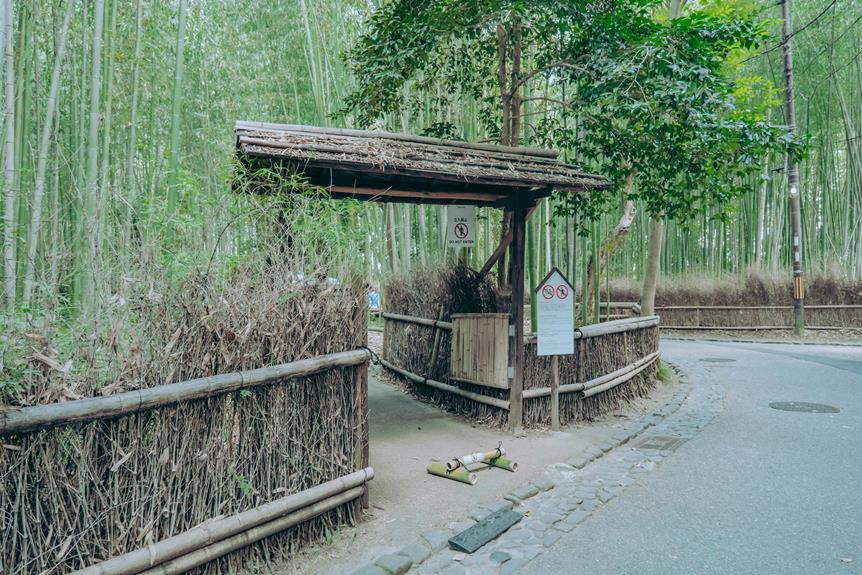Nestled at the foothills of Mount Fuji, Aokigahara Forest in Japan beckons visitors with its lush greenery and ancient lava caves. However, beyond its serene facade lies a darker undercurrent of mystery and folklore that has shrouded this place in an unsettling aura. As visitors explore the hidden trails and venture into the depths of the forest, they may find themselves captivated by more than just its natural beauty. The enigmatic origins and haunting encounters within Aokigahara Forest invite a deeper investigation into the complexities that lie beneath its surface, leaving one both intrigued and cautious to uncover its secrets.
Key Takeaways
- Located at Mount Fuji's base, Aokigahara is a mysterious forest known as the 'Sea of Trees.'
- Rich biodiversity with unique flora and fauna like Japanese cedar, wild boar, and mosses.
- Historical association with suicide contemplation and cultural taboos, evoking strong emotions.
- Offers hidden trails, lush greenery, and caves formed by ancient lava flows for exploration.
- Conservation efforts focus on ecosystem balance, habitat restoration, and community engagement for awareness.
The Enigmatic Origins of Aokigahara
Shrouded in mystery and historical significance, the origins of Aokigahara Forest in Japan have long puzzled researchers and historians alike. This dense forest, located at the northwestern base of Mount Fuji, is steeped in enigmatic legends and tales of ancient spirits that have captured the imagination of many. The name 'Aokigahara' itself means 'Sea of Trees,' a fitting description for this lush expanse that covers approximately 14 square miles.
The forest's origins are intertwined with both geological and cultural history. Formed over centuries through volcanic activity, Aokigahara's dark volcanic soil provides a fertile ground for the diverse flora and fauna that call it home. However, beyond its geological formation lies a tapestry of intriguing folklore and legends that have contributed to its mystique.
Legends of yurei, or restless spirits, are said to roam the forest, adding to its eerie reputation. These ancient beliefs have led to the forest being associated with death and the supernatural in Japanese folklore. Some stories even suggest that Aokigahara was a place where individuals would go to die in solitude, further adding to its mysterious allure.
Despite the myths and legends that surround Aokigahara, scientific research continues to unravel the forest's true origins and ecological significance. Through geological studies and ecological surveys, researchers aim to uncover the secrets hidden within this ancient forest, shedding light on its enigmatic past while respecting its cultural and historical importance.
Flora and Fauna of the Forest
With a rich diversity of plant and animal species, Aokigahara Forest in Japan showcases a unique ecosystem that thrives within its dense expanse. The forest is known for its biodiversity exploration, offering researchers a glimpse into the delicate ecological balance of this intriguing environment.
Aokigahara Forest is home to a variety of wildlife habitats, providing shelter and sustenance for numerous species. Among the fauna that inhabit the forest are Japanese serow, wild boar, and bird species such as the great spotted woodpecker and the varied tit. These animals contribute to the intricate web of life within the forest, playing essential roles in maintaining the ecosystem's equilibrium.
In addition to its diverse wildlife, Aokigahara boasts a rich array of plant species. The forest features a mix of coniferous and broadleaf trees, including iconic species like Japanese cedar and maple trees. Mosses, ferns, and wildflowers carpet the forest floor, adding to its lush and vibrant tapestry.
The intricate relationship between the plant and animal species within Aokigahara Forest highlights the importance of preserving its delicate balance. As visitors explore this fascinating landscape, they are reminded of the interconnectedness of all living organisms and the need to protect and respect the natural world around us.
Dark History and Folklore Surrounding Aokigahara
The enigmatic reputation of Aokigahara Forest in Japan is intertwined with a dark history and intriguing folklore that have captivated the interest of many. This forest, also known as the Sea of Trees, has long been associated with cultural taboos and psychological implications that add to its mystique.
Cultural taboos surrounding Aokigahara stem from its historical association with death. The forest has been a site where individuals have historically gone to contemplate suicide, leading to a somber aura that permeates the area. This association with death has created a sense of unease and reverence among the Japanese population.
The psychological implications of Aokigahara are profound. The dense vegetation and the quietness of the forest create an eerie atmosphere that can evoke a range of emotions in visitors, from a sense of foreboding to introspection. The tragic history of the forest adds to the psychological weight it carries, making it a place that elicits strong emotions from those who enter its depths.
Navigating the Trails and Caves
Exploring Aokigahara Forest involves traversing a network of trails and caves that wind through its dense vegetation and unique geological formations. The hidden trails offer a sense of adventure as visitors navigate through the lush greenery, with the potential to discover secluded spots and breathtaking views. These trails vary in difficulty, catering to both casual hikers and experienced trekkers.
The caves within Aokigahara provide an intriguing opportunity for exploration. Formed by ancient lava flows, these caves offer a glimpse into the geological history of the region. Venturing into these subterranean spaces requires caution and proper equipment due to the uneven terrain and low light conditions. However, for those willing to embrace the challenge, the caves reveal stunning rock formations and a sense of mystery that adds to the allure of the forest.
As visitors traverse the trails and explore the caves, they are surrounded by a rich diversity of flora and fauna. The forest's ecosystem supports a wide variety of plant and animal species, making each hike a unique encounter with nature. From towering trees to delicate wildflowers, Aokigahara showcases the beauty of Japan's natural landscapes.
Conservation Efforts and Challenges
Conservation efforts in Aokigahara Forest are paramount in safeguarding the delicate balance of its ecosystem amidst ongoing environmental challenges. The forest, known for its rich biodiversity and unique geological features, faces a range of ecological challenges that require immediate attention to secure the preservation of its natural heritage. Wildlife conservation efforts are vital in protecting the diverse array of flora and fauna that call Aokigahara home.
To address the conservation needs of Aokigahara Forest, the following measures have been implemented:
- Habitat Restoration: Initiatives are underway to restore degraded habitats within the forest, aiming to enhance biodiversity and provide a healthier ecosystem for its inhabitants.
- Invasive Species Management: Control programs target invasive species that threaten the native plants and animals of Aokigahara, helping to maintain the balance of the forest ecosystem.
- Community Engagement: Collaborative projects involving local communities focus on raising awareness about the importance of conservation and fostering a sense of stewardship among residents and visitors.
- Research and Monitoring: Ongoing research activities and monitoring programs track changes in the forest ecosystem, providing valuable data for informed conservation decision-making.
Haunting Encounters and Supernatural Beliefs
Reports of eerie encounters and deeply-rooted supernatural beliefs intertwine with the mystique surrounding Aokigahara Forest in Japan. This dense, sprawling forest has gained a reputation for supernatural occurrences and ghost stories, attracting both thrill-seekers and those interested in the paranormal.
Visitors to Aokigahara Forest have reported unsettling experiences, including hearing whispers in the wind, feeling a sense of being watched, and encountering unexplained shadows among the trees. Some individuals claim to have seen apparitions of restless spirits wandering the forest, adding to its mysterious aura.
Local folklore and superstitions contribute to the belief that Aokigahara Forest is a place where the boundary between the living and the dead is blurred. It is said that the spirits of those who have met tragic ends in the forest linger on, seeking solace or companionship. These tales have been passed down through generations, further fueling the supernatural lore surrounding the area.
While scientific explanations exist for many of the reported phenomena in Aokigahara Forest, the allure of the unknown and the human fascination with the supernatural continue to attract people to this enigmatic location. Whether fueled by genuine belief or a desire for adventure, the haunting encounters and supernatural beliefs associated with Aokigahara Forest add a layer of intrigue to its already complex reputation.
Photography Tips for Visitors
When capturing photographs in Aokigahara Forest, visitors should consider the unique lighting conditions and the forest's natural features to enhance the visual impact of their images. To make the most of your photography experience in this mystical forest, follow these tips:
- Composition Techniques and Lighting:
- Utilize the dappled sunlight filtering through the dense foliage to create mesmerizing light and shadow effects.
- Incorporate the twisted tree roots, vibrant moss-covered rocks, and the eerie stillness of the forest to add depth and mystery to your compositions.
- Camera Settings and Equipment:
- Use a wide-angle lens to capture the vastness of the forest or a macro lens to focus on intricate details like moss or ferns.
- Experiment with different aperture settings to control the depth of field and isolate subjects against the forest backdrop.
- Consider using a tripod to guarantee sharp images, especially in low-light conditions or when capturing long exposure shots of the forest interior.
Responsible Tourism Practices
What ethical considerations should visitors to Aokigahara Forest prioritize to guarantee minimal impact on the ecosystem and cultural significance of the area?
When engaging in sustainable travel to Aokigahara Forest, it is important for visitors to adopt ethical exploration practices to preserve the delicate balance of this unique ecosystem. Sustainable travel involves respecting the natural environment, minimizing waste generation, and supporting local communities.
To promote minimal impact on the ecosystem, visitors should stay on designated trails to avoid trampling vegetation and disturbing wildlife habitats. Littering is strictly prohibited, and any waste generated must be carried out of the forest to maintain its pristine condition. Additionally, refraining from removing any plants, rocks, or other natural elements helps preserve the biodiversity of the forest.
Ethical exploration also encompasses respecting the cultural significance of Aokigahara Forest. Visitors should be mindful of the forest's history and significance to the local community, refraining from engaging in any activities that may disrespect or disturb sacred sites. Additionally, seeking permission before photographing individuals or cultural landmarks is essential to uphold ethical standards while visiting the area.
Frequently Asked Questions
Are There Any Specific Rules or Taboos for Visitors in Aokigahara Forest?
When visiting certain locations, it is vital to uphold cultural customs and demonstrate respectful behavior towards the environment and local traditions. Folklore and spiritual beliefs often influence the rules and taboos set for visitors.
These guidelines help to maintain the sanctity of the area and show reverence for the beliefs held by the community. Adherence to these practices guarantees a harmonious interaction between visitors, the environment, and the local culture.
What Measures Are in Place to Prevent Lost Hikers in the Forest?
Navigation techniques play a vital role in preventing lost hikers in dense forests. Safety protocols such as utilizing maps, compasses, and GPS devices are essential for hikers to stay on course.
In case of emergencies, efficient emergency procedures like contacting authorities or activating distress signals are in place. Search parties equipped with specialized tools and knowledge are deployed to locate lost hikers swiftly and guarantee their safe return.
Is There Any Scientific Explanation for the Eerie Atmosphere in Aokigahara?
Scientific studies have investigated the phenomenon of eerie atmospheres reported in various locations. While there is no conclusive evidence to support claims of paranormal activity, researchers have explored environmental factors such as geological formations, electromagnetic fields, and infrasound levels that could influence human perception and emotions.
These studies aim to provide rational explanations for the unsettling feelings experienced in certain places, shedding light on the mysteries of eerie environments.
How Do Local Authorities Handle Cases of Missing Persons in the Forest?
Local authorities employ thorough search and rescue protocols when handling cases of missing persons. These protocols usually involve coordination between law enforcement, search teams, and crisis intervention specialists. Search efforts are typically organized systematically, utilizing specialized techniques to cover the area efficiently.
Crisis intervention techniques are also employed to provide support to families and loved ones during the search process, ensuring a holistic approach to handling such delicate situations.
Are There Any Guided Tours Available for Exploring Aokigahara?
When seeking to explore the tranquil beauty of nature, individuals often wonder about the availability of guided tours. These eco-friendly tours not only provide an opportunity to appreciate the natural environment but also play an essential role in supporting conservation efforts.
Additionally, such excursions offer a unique chance to immerse oneself in the cultural significance and spiritual practices associated with the area, creating a truly enriching experience for those seeking to connect with nature.
Conclusion
Intriguingly, Aokigahara Forest experiences an average of 50 to 100 suicides per year, making it one of the most popular sites for such tragic occurrences in Japan.
This statistic sheds light on the dark history and somber reputation of the forest, adding to its enigmatic allure and prompting further exploration into the complex intertwining of nature, folklore, and human psychology within this unique ecosystem.


